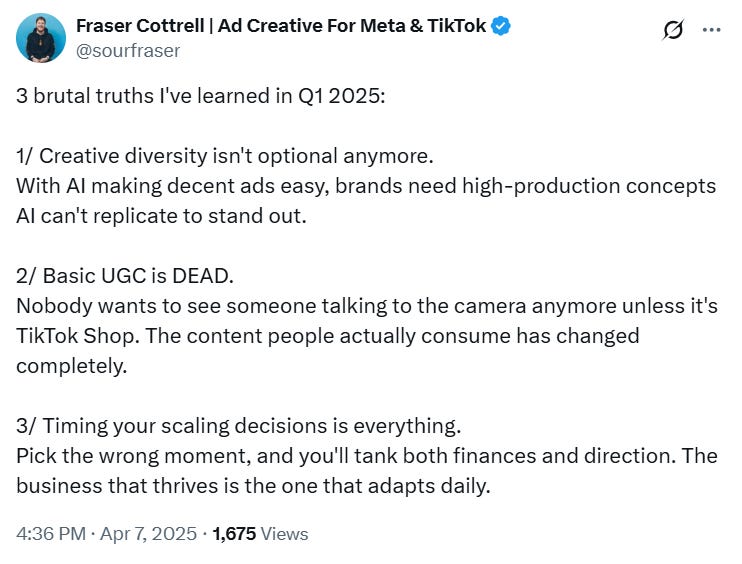Perfect narratives are a myth!
🧠 The Narrative Illusion: Your brain fills in more than you think, Google’s expanding AI toolkit in search and listings, and more!
Howdy Readers 🥰
In this newsletter, you’ll find:
🧠 The Narrative Illusion: Your Brain Fills in More Than You Think
🔍 Google’s Expanding AI Toolkit in Search and Listings
🚀 Tweet of the Day
If you’re new to Buyology then a hearty welcome to you, You’ve reached the right place alongside 50k+ amazing people, Before you forget, if someone forwarded this newsletter to you, don't forget to subscribe to our newsletter so you never miss out!
Together with SEMrush
Mobile, Visual Ads, and AI: Win in 2025 with Key Growth Drivers Found Inside the New Report from Semrush & Euromonitor
Consumers are shifting—and fast. In 2024, mobile drove 60% of FMCG ecommerce traffic, display ads spiked 156%, and AI referrals soared 1138%.
Semrush and Euromonitor International unpack the data reshaping the digital shelf, from mobile-first strategies to the rise of visually-driven shopping and AI-powered discovery.
Want to see how leading brands are adapting—and where the biggest opportunities lie?
The free FMCG ecommerce report is your roadmap to smarter ecommerce in 2025 and beyond!
Get your report for free today!
🧠 The Narrative Illusion: Your Brain Fills in More Than You Think
The most persuasive ads don’t tell the whole story—they let the brain do the storytelling.
We’ve been taught to “craft the perfect narrative,” but that assumes attention is linear and generous. It isn’t. The mind consumes fragmented, partial information and reconstructs meaning. And this is where great ads operate—not by completing the thought, but by initiating it.
Welcome to The Narrative Illusion: where creative is designed to be incomplete—on purpose.
1. Create Gaps That Demand Closure
Humans are wired for closure. Show half the punchline, and the mind must resolve it. Great creative leans into this. It doesn’t over-explain. It plants seeds of tension, then trusts the viewer to close the loop.
Examples? An unspoken transformation. A question without an answer. A product shown, but never fully explained. The ad becomes a doorway—not a destination.
Pro Tip: Script your ads like riddles. Not mysteries. Give just enough for the mind to feel clever when it “gets it.”
2. Use Visuals as Subtext, Not Supplement
In weak ads, visuals repeat what the script says. In great ads, visuals replace the words.
That’s because the visual cortex processes faster than language. It also connects deeper, directly to memory, emotion, and meaning.
Layering symbolism, contrast, or visual contradiction allows the viewer to experience “aha” moments without a word. That’s narrative magic.
Tools like Motion’s Expert Agents analyze which visual frames drive emotional recall and drop-off—essential to crafting illusion, not exposition. They are designed by the world’s best creative strategists who actively manage and grow high-scale ad accounts. You can get early access to Motion's Expert Agents here!
3. Let Silence Speak
Narrative silence isn’t the absence of information—it’s space for interpretation.
The pause in a line. The lingering shot. The delayed reveal.
These are the emotional beats where belief forms. Not because you said it. But because the audience felt it and then told themselves, “this is for me.”
Takeaway:
The most effective creative doesn’t complete the message. It leaves strategic gaps—forcing the brain to construct meaning.
You don’t need better storytellers. You need better illusionists.
Craft ads that whisper, not scream. Let the audience write the last line in their head. Because when they finish the story, they believe it’s their own. And nothing sells better than self-conviction.
🔍 Google’s Expanding AI Toolkit in Search and Listings
Insights from Social Media Today
Google is ramping up its AI initiatives across Search, Maps, business reviews, and even cultural content — aiming to improve trust, personalization, and user engagement through Gemini-powered systems and experimental tools.
The Breakdown:
1. Smarter Fraud Detection in Maps - AI now blocks millions of fake edits and business listings, using models trained by Gemini to flag suspicious changes, like abrupt shifts in business categories. Over 12M fake profiles and 70M policy-violating edits were removed in 2023 alone.
2. Review Monitoring & Alerts - Google AI is scanning for suspicious review behavior and now issues warnings on listings with unusual activity. Live in the U.S., U.K., and India, this update hopes to curb fake reviews and restore trust in Google listings.
3. AI-Powered Search & Visual Understanding - AI Mode in Search, now available to all Labs users, supports longer queries, comparisons, and travel planning. New multimodal capabilities let users upload images and ask context-rich questions powered by Lens + Gemini fusion.
Google’s AI upgrades aim to rebuild trust in its platforms and redefine how users interact with information, from stopping fraud to enhancing discovery. As Gemini weaves into more products, Google positions itself for deeper user engagement across search, content, and commerce.
🚀 Tweet of the Day
Advertise with Us
Wanna put out your message in front of over 50,000 best marketers and decision makers?
Checkout our Partner Kit here🤝
At Buyology, we care about our readers and want to provide the best possible experience. That's why we always look for ways to improve our content and connect with our audience. It would be amazing if you could hit us up with feedback about our content or absolutely anything, we are always up for a chat 🥰
Thanks for your support, We'll be back with more such content 🥳



